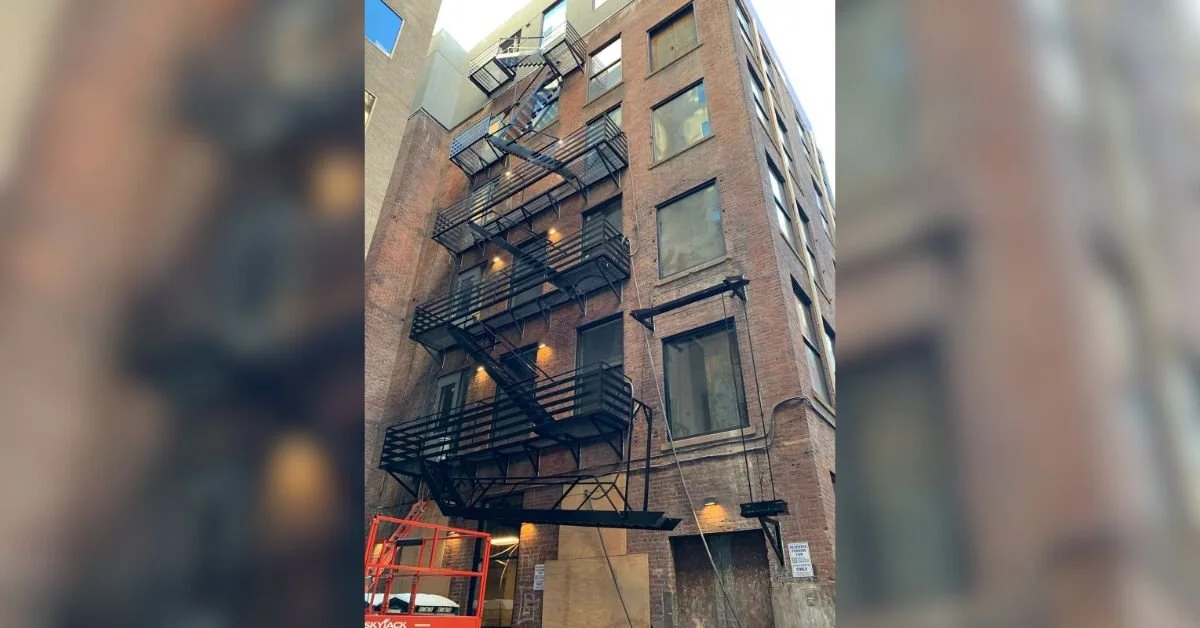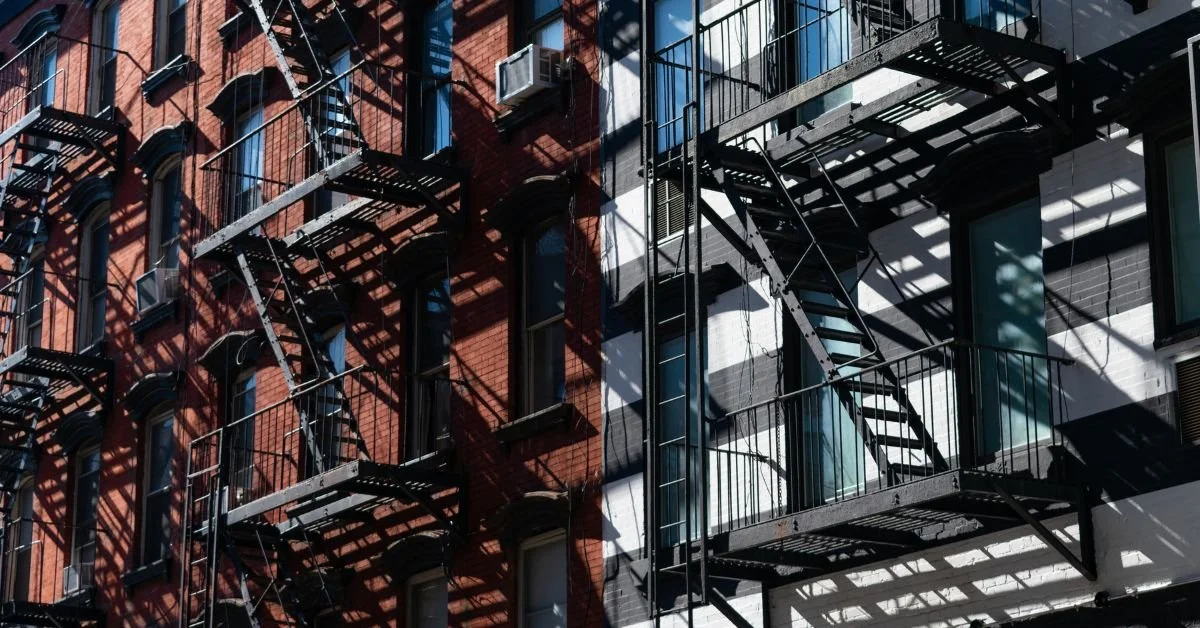Comparing Counter-Weighted/Counter-Balanced Stairs & Ladders
Counter-weighted systems (also sometimes called counter-balanced systems) are essential for providing safe and functional access to elevated areas, particularly in emergency escape settings. Two popular options include counter-weighted stairs and counter-weighted ladders.
If you’re unsure which system best suits your property, compare and consider counter-weighted stairs and counter-weighted ladders in terms of their design, usability, and maintenance requirements to implement the right solution.
Design and Structure
The design and structure of a system influence its functionality, versatility, and space requirements. While both counter-weighted stairs and ladders fulfill similar purposes, their designs differ significantly in practicality and installation.
Counter-Weighted Stairs/Counter-Balanced Stairs
Counter-weighted or counter-balanced stairs resemble traditional staircases with added components for controlled movement. Engineers construct these systems to lower automatically when needed, a mechanism that supports quick access during emergencies. However, their bulkier design often requires significant space, making them less adaptable for compact areas or narrow setups.
Counter-Weighted Ladders/Counter-Balanced Ladders
Counter-weighted or counter-balanced ladders employ a vertical structure with guided tracks and a system that allows seamless movement. The design maximizes vertical efficiency while maintaining strength. This makes them a versatile choice for properties where space optimization is paramount. A counter-balanced ladder’s streamlined vertical structure offers adaptability without sacrificing safety or reliability.
Installation and Space Efficiency
Each system’s installation process varies based on the time, labor, and cost involved. Additionally, space efficiency determines its viability for specific property layouts, especially in urban areas with limited room.
Implementing Counter-Weighted Stairs
The installation of counter-weighted stairs often involves extensive structural modifications to accommodate their larger footprint. They require adequate clearance and sturdy foundations to ensure stability during operation. This, inclusive of the need for more materials such as steel, can contribute to higher upfront costs for property managers and owners.
Installing Counter-Weighted Ladders
Counter-weighted ladders offer easier and faster installation since they’re more compact. They involve minimal modifications to existing structures and lend themselves to retrofitting into buildings without significant disruptions to tenants.
Counter-weighted ladders provide a clear advantage in installation and space efficiency. Their simplicity reduces installation complexities and makes them a practical choice for cost-conscious property managers and owners.
Safety
Safety is an imperative factor in the selection of emergency escape systems. Comparing counter-weighted stairs and counter-weighted ladders in this aspect requires you to consider how easily people would be able to use them in an evacuation.
Features of Counter-Weighted Stairs
Counter-weighted stairs are generally considered user-friendly due to their gradual incline and accommodations to a wide range of users, including children. Nevertheless, their exposed mechanisms may require regular checks to ensure functionality and prevent accidents.
Components of Counter-Weighted Ladders
The compact designs of counter-weighted ladders reduce the risk of mechanical failures caused by external elements. Other safety features include anti-slip coatings, sturdy rungs, and secure handrails.
While both systems prioritize safety, counter-weighted stairs offer better accessibility for diverse user groups. However, for property managers and owners looking to prioritize long-term durability and low maintenance risks, ladders remain a strong contender.
Maintenance and Longevity
Proper maintenance guarantees the functionality of counter-weighted systems while extending their lifespan. Differences in design and exposure to wear and tear affect the maintenance demands of stairs and ladders.
Maintaining Counter-Weighted Stairs
Due to their larger size and exposed mechanisms, counter-weighted stairs require frequent inspections and maintenance from construction professionals. The moving parts are more susceptible to environmental exposure, leading to potential corrosion, misalignment, or component failure.
Maximum Fire Escapes’ licensed welders are proficient in repairing counter-weighted/counter-balanced staircases and ensuring your staircase is in good condition.
Caring for Counter-Weighted Ladders
Counter-weighted ladders, with their simpler design and fewer moving components, are comparatively easier to maintain, especially since their structures reduce exposure to environmental stressors. Taking care of these structures requires specialized knowledge about fire escape construction, inspection, and repair.
The team of licensed welders at Maximum Fire Escapes has years of experience conducting thorough fire escape inspections and providing comprehensive reports. We’ll help you preserve the functionality and condition of your fire escape’s counter-weighted ladder by inspecting ladder tracks, lubricating pulleys and cables, verifying counter-weight seals, and tightening clamps.
Cost Effectiveness
The overall cost of an emergency access system includes installation, short-term expenditure, and long-term value. Understanding these financial aspects helps property managers and owners decide which option delivers the best return on investment.
Costs Related to Counter-Weighted Stairs
Counter-weighted stairs typically incur higher costs during installation due to their structural demands, including more material, and the space they occupy. Ongoing maintenance adds to the expenses, particularly in areas that endure harsh weather conditions, which can accelerate wear and tear.
Fees for Counter-Weighted Ladders
Although the initial cost of counter-weighted ladders can vary depending on their design and material, they are generally more budget-friendly to install. Their reduced maintenance further enhance their cost-efficiency. The lower frequency of repairs and replacements also translates into greater savings over time.
Ideal Applications
Specific scenarios and property types influence which system works best. Understanding their strengths in practical applications helps property managers and owners determine the better choice for their unique situations.
Applications of Counter-Weighted Stairs
Counter-weighted stairs suit buildings that prioritize accessibility above all else. Examples may include schools, hospitals, and residential properties with diverse occupants. However, their space requirements can make them unsuitable for some urban settings.
Use Cases for Counter-Weighted Ladders
Counter-weighted ladders excel in areas that demand compact and efficient emergency solutions. If your building is a high-rise or you operate an industrial facility or property with limited outdoor clearance, ladders are particularly advantageous.
Their smaller footprint enables compliance with safety standards without compromising space. Plus, the versatility of counter-weighted ladders makes them a more adaptable choice for diverse applications.
Encouraging Proper Maintenance Practices
Regardless of the system you choose, routine inspections and consistent maintenance are necessary to ensure safety and reliability. A proactive approach transforms your counter-weighted system into a dependable safety mechanism for years to come.
Property managers who emphasize proper upkeep set a strong foundation for compliance and employee and occupant protection. Encouraging staff to report potential issues promptly supports safety initiatives. It is also good to keep a record of your routine management acts by documenting inspections, repairs, and upgrades.
Choosing the Best System for Your Property
When comparing counter-weighted stairs and ladders, counter-weighted ladders emerge as the more efficient, versatile, and cost-effective option for many property types. Nevertheless, stay diligent in maintaining the system of your choice by collaborating with reputable experts in emergency egress design, function, and care to maximize safety and usability.
Investing in the right solution, along with consistent maintenance, guarantees your building will be able to sufficiently meet emergency needs.



